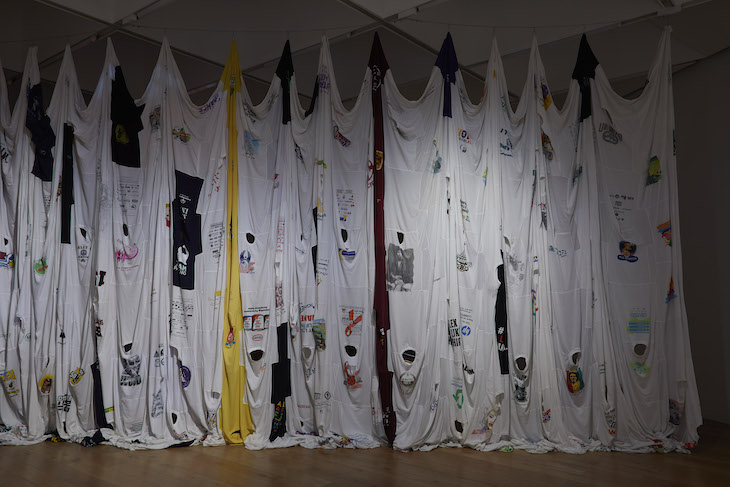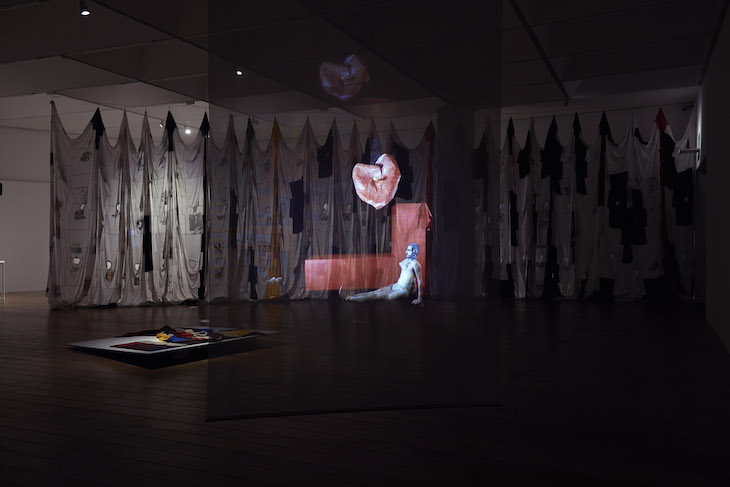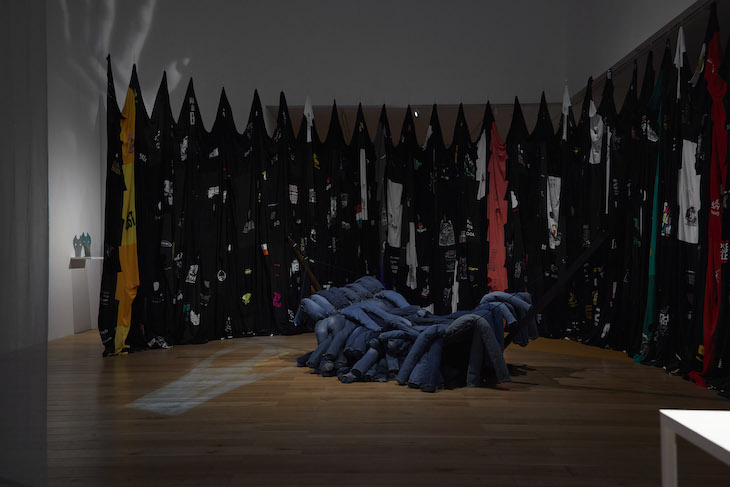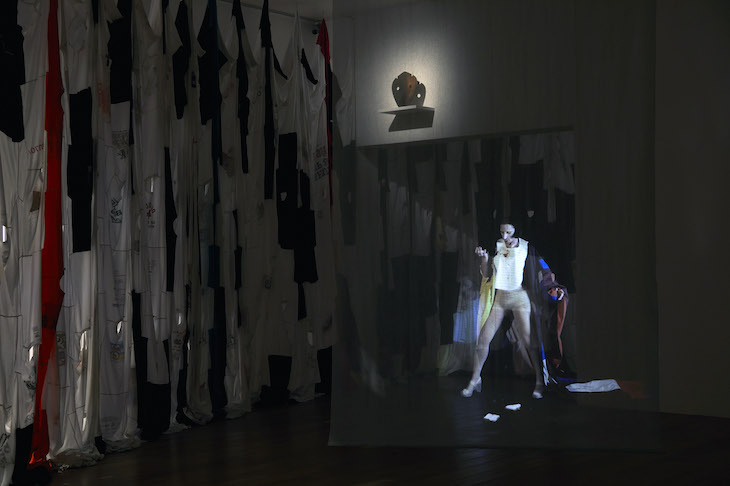Pia Camil’s first solo exhibition in the UK might be called ‘Split Wall’ but it is actually entirely walled in. The large windows at Nottingham Contemporary that usually offer passers-by a sneak preview have been blocked up, and even the glass doors at the front of the space remain covered. The only way to experience the Mexican artist’s work is to step inside the gallery. Camil invites us to view her new and existing output in a detached landscape; there is to be no connection between the city streets outside and the art inside. This is surprising for an artist who has spent a large part of her career creating work in response to urban spaces, economics and the media. She has explored cross-border trade in Mexico (the city very much informs Camil’s work), recreated billboards using fabric, and produced performances in the streets of Guatemala City. Yet in Nottingham she places us in a dark room with only a short script to guide us.
Installation view of Fade into Black (2017) by Pia Camil, Nottingham Contemporary, 2018. Photo Stuart Whipps; courtesy the artist

On entering the exhibition, this isolation starts to make sense, for ‘Split Wall’ is a different and intriguing world that requires new ways of behaving and perceiving. Lots of familiar objects appear, but are here viewed afresh. Fade into Black (2017) sees Camil repurpose a mass of t-shirts into the building blocks of a theatrical 100-metre-long architectural structure that winds across the exhibition. The t-shirts were purchased at the Iztapalapa market in Mexico City and were originally made in Latin America for the US market, only to be illegally imported back to Mexico. Fade into Black almost looks like a border and yet it is made of items that have gone on their own cross-border journey. The work might tell a striking story about mass production and global economics, but its curious physicality is what draws attention; walls are usually associated with security, whereas Camil’s is soft and full of head-sized holes that can be spied through.
Installation view of ‘Pia Camil: Split Wall’, Nottingham Contemporary, 2018. Photo Stuart Whipps

It is through these holes that we first glimpse Split Wall (2018), a newly commissioned video work in five acts, projected on to gauze screens and displayed separately throughout the gallery. It stars an androgynous character named They who interacts with many of the other ceramics, masks and textiles found in the exhibition. The videos include sound effects, but They largely remains silent. Context comes from a script written by Gabriela Jauregui in which They’s actions are described in poetic detail. In Vase, They emerges from a red ‘L’ shape and the script notes: ‘They come out of their house like a letter out of an envelope. Fresh, crisp.’
Installation view of Fragmento L (2014) by Pia Camil, Nottingham Contemporary, 2018. Photo Stuart Whipps

As the title of the exhibition suggests, Split Wall (2018) is the centre around which the show rotates. The aforementioned ‘L’ shape appears again in the gallery in the form of a small ceramic vase; They’s colourful tunic is laid out on the floor; blue jeans (also from Iztapalapa market) from They’s dance routine are reconfigured as cushions and a giant hammock, and a mini version of a mask They inhabits stands on a plinth. The line between reality and fantasy becomes blurred, and as we read Jauregui’s script and perceive They it becomes impossible to shake the feeling that we are also being watched. After all, we exist in a space with many of the same objects.
Installation view, Vicky’s Blue Jean Hammock 2 (2018) in front of Fade into Black (2017) by Pia Camil, Nottingham Contemporary, 2018. Photo: Stuart Whipps; courtesy of the artist

To add to these fading boundaries, They mimics many recognisable activities – lying on a beach reading, eating a sandwich, dancing with abandon, removing nail varnish, cleaning teeth. Mask records They living inside a mask that resembles a house, carrying out domestic chores like hoovering, putting the dish washer on and dusting. Watching They carry out these identifiable tasks within a mask, and in a public arena, suggests a performative element even within the private domestic space.
Installation view of ‘Pia Camil: Split Wall’, Nottingham Contemporary, 2018. Photo Stuart Whipps

The original ceramic mask that becomes They’s home in Split Wall also reveals the extent to which Camil is considering questions around an individual’s public image. The seven mystical masks included in this show (made in collaboration with Narciso Vallejo) were inspired by Carl Jung’s concept of persona – the public image or identity we create for ourselves. Scattered throughout the gallery, the eyeless faces act as observers, watching our reactions as we fixate on They. By immersing ourselves within the exhibition, surrounded by the props that feature in the films, we are unable to remain passive. As we recognise ourselves in They’s actions, we are forced to question how we present ourselves to the world, to question whether we feel comfortable lying atop a hammock of jeans that stands as a symbol for mass consumption.
Installation view of Bust Mask Sigilata Black (2018; left) and Bust Mask Copper and Jade I (2018; right) by Pia Camil, Nottingham Contemporary, 2018. Photo: Stuart Whipps; Courtesy of the artist and Galerie Sultana

Although ‘Split Wall’ is presented in a vacuum, there is an unsettling sense of déjà vu that haunts the exhibition. We constantly encounter objects and behaviours that are both deeply familiar and entirely unfamiliar. Camil does not try to disguise the t-shirts and jeans that appear in her sculptures, nor does she deny the humanity of a mask – even giving one hair. Consequently, Camil has managed to create a show in which we have seen everything and nothing before.
‘Pia Camil: Split Wall’ is at Nottingham Contemporary until 7 October.



